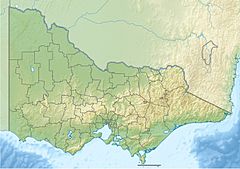New Guinea II cave facts for kids
| Location | near Buchan, Victoria |
|---|---|
| Region | Australia |
| Coordinates | 37°23′5″S 148°21′3.6″E / 37.38472°S 148.351000°E |
| Site notes | |
| Excavation dates | 1980s |
| Archaeologists | Paul Ossa |
New Guinea II is a special limestone cave and rockshelter (a natural rock overhang) located near the Snowy River in Victoria, Australia. It's close to a town called Buchan. This cave was once part of the land belonging to the Krowathunkooloong clan of the Gunaikurnai nation.
The cave has a large overhanging cliff. This cliff forms a natural shelter at the entrance, which faces the river. In the 1980s, a team of archaeologists led by Paul Ossa from LaTrobe University explored the cave. They found ancient stone tools and other signs that people lived there. These discoveries show that humans were using the cave almost 20,000 years ago!
Contents
Exploring New Guinea II Cave
New Guinea II is one of three important cave systems found in the middle Snowy River area. The others are New Guinea Cave (NG-1) and Nuigini Namba Fav Cave (NG-5, NG-6).
Inside the Cave
The entrance of New Guinea II cave leads into a big chamber. There's also a passage with a stream that flows all year round. The cave has several entrances.
Mysterious Wall Markings
Inside the cave, archaeologists found special marks on the dried mud walls. These marks look like they were made by fingers or tools. Experts believe they were made by Aboriginal people a very long time ago. These marks are similar to those found in Koonalda Cave in South Australia. New Guinea II is the first place in Victoria where such ancient markings have been discovered.
Some people think animals might have made the marks. However, many of them form clear patterns, like circles and diagonal crosses. They are often found on smooth parts of the walls. Some are even in dark, hard-to-reach areas of the cave.
Home to Bats
Deep inside the cave's large chamber, you can find Bent Wing bats. These bats gather there, making the cave an important home for them.
Life in the Ancient Cave
People used New Guinea II cave on and off for more than 20,000 years. This means different groups of people visited or lived there over a very long time.
Ancient Tools and Fires
Archaeologists found small but steady amounts of stone tools and bone items. They also found evidence of a fireplace on a dry part of the cave floor, near the stream. This shows that people cooked and kept warm inside the cave.
Animal Visitors
The cave also has many animal bones. Most of these bones are from animals that used the cave when humans were not there. This means the cave was a shelter for both people and animals at different times.
Connecting the Past
The tools found at New Guinea II are similar to those from Cloggs Cave nearby. They are also like discoveries made at Birrigai in the ACT. Together, these sites help us understand how people lived and used resources in southeastern Australia during the Pleistocene (the Ice Age).
These findings suggest that people used caves and shelters in this area in a non-intensive way. They mostly used local animals for food. This is different from some ancient sites in Tasmania, where people seemed to rely heavily on one type of animal.



